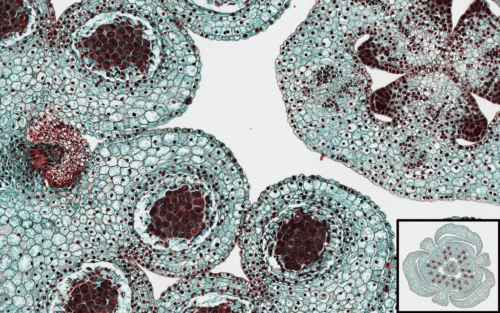BIOL-033 | Slides maybe purchase individually or as custom collections. If you wish to purchase 25 or more virtual slides, discounts will be automatically applied according to incremental package sets of 25, 50, 100, 200, or unlimited.
Marchantia All Stages c.s, 400X c.s.
Product Description
Marchantia is a genus in the family Marchantiaceae of the order Marchantiales, a group of liverworts. Marchantia can reproduce both sexually and asexually. Sexual reproduction involves sperm from antheridia on the male plant fertilizing an ovum (egg cell) in the archegonium of a female plant. The antheridia and archegonia are borne atop special gametophore stalks called antheridiophores and archegoniophores, respectively. These are borne on separate thalli; hence, the plants are dioicous. Once fertilized, the ovum is called a zygote and develops into a small sporophyte plant, which remains attached to the larger gametophyte plant. The sporophyte produces spores which develop into free-living male and female gametophyte plants. Asexual reproduction occurs by means of gemmae, discoid clumps of cells which are genetically identical to the parent and contained in cup-like structures on the upper surface of the plant. These are dispersed when rain splashes into the cups and develop into new plants. Asexual reproduction can also occur when older parts of the plant die and the surviving newer branches develop into separate plants.













